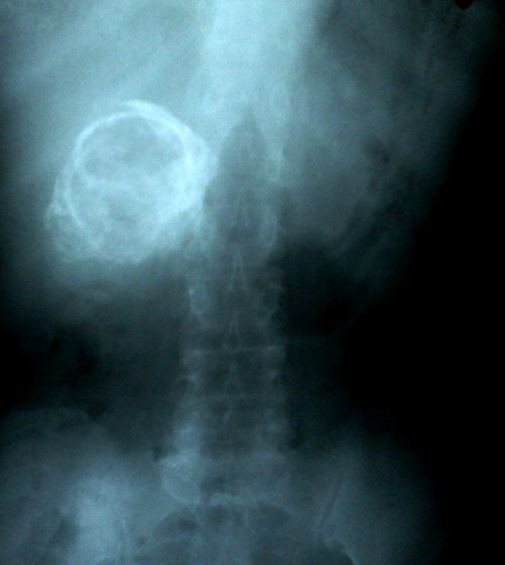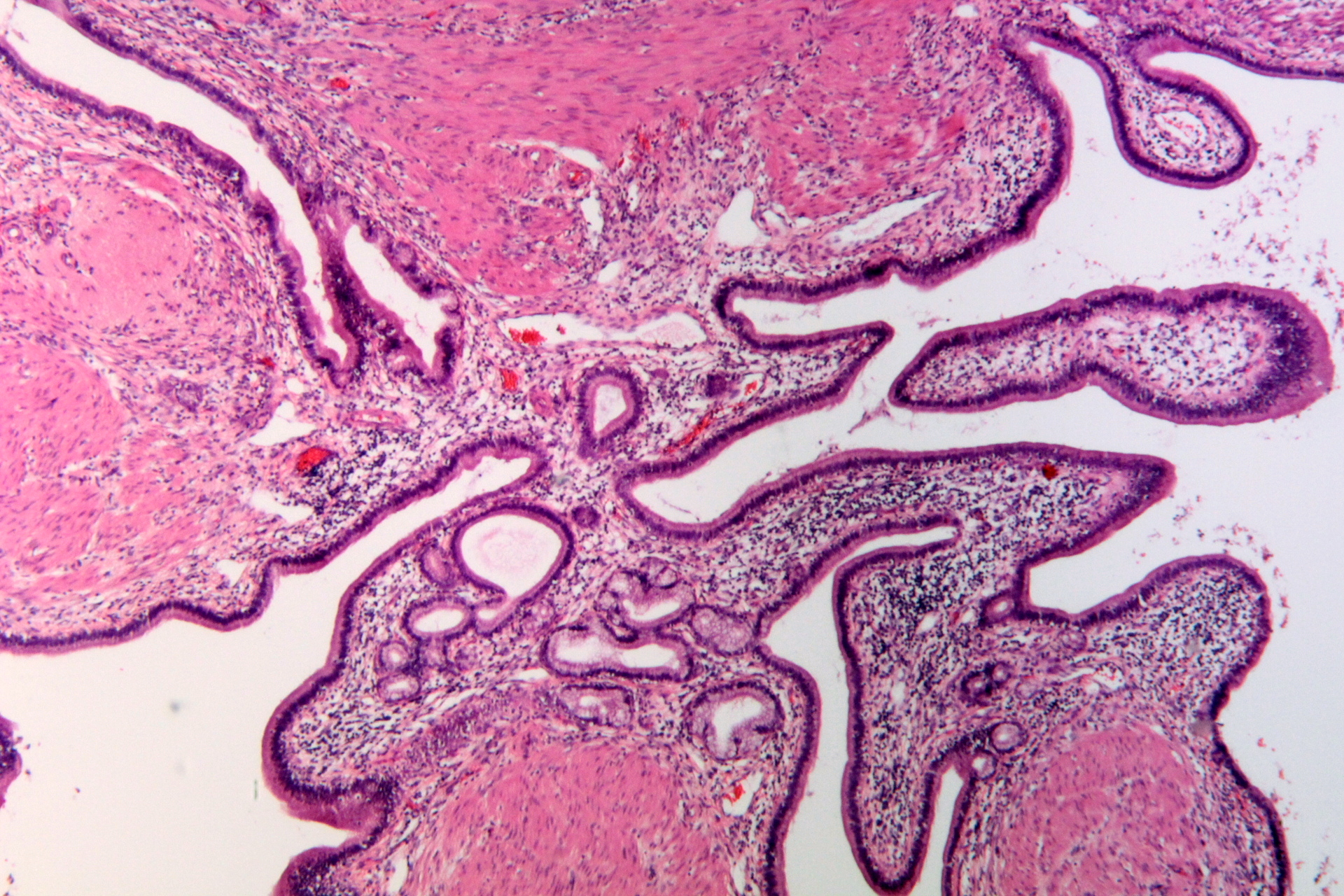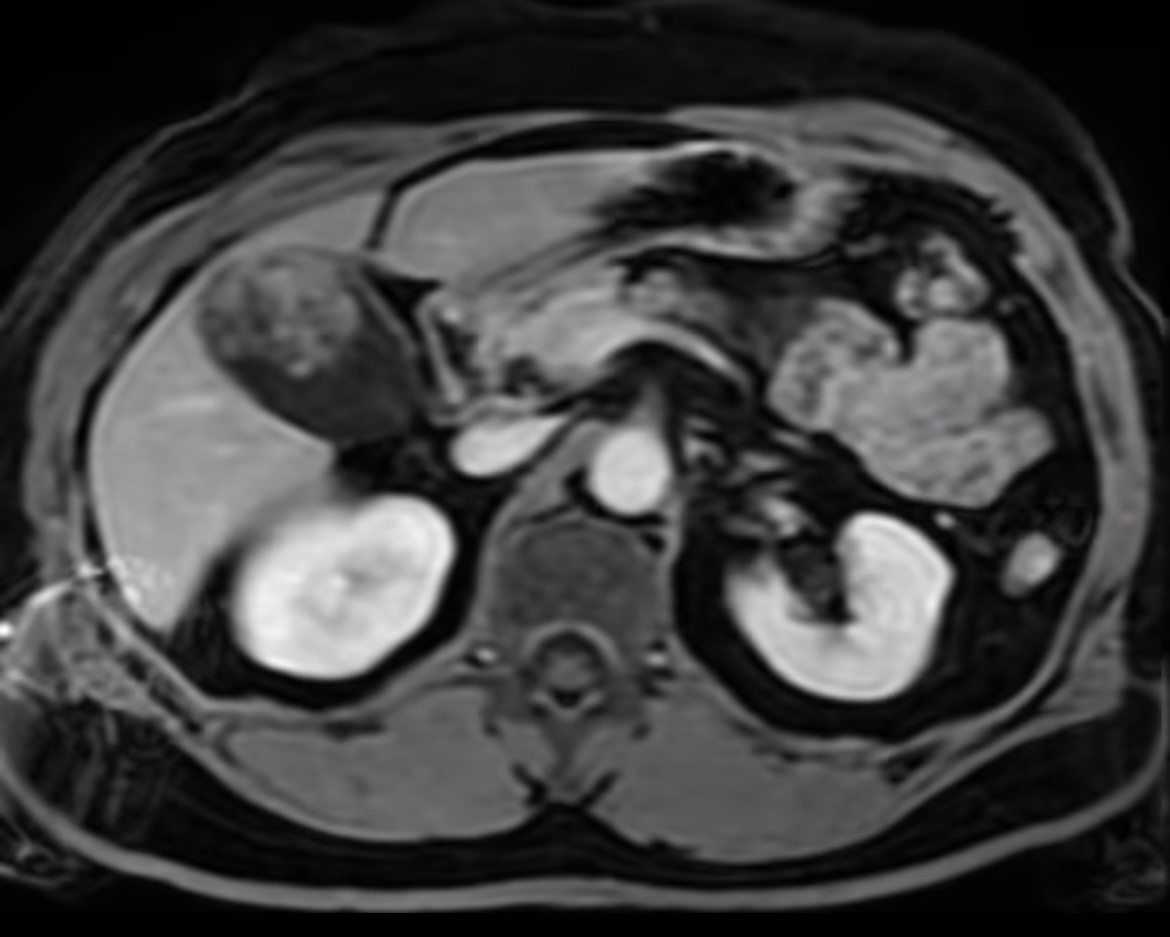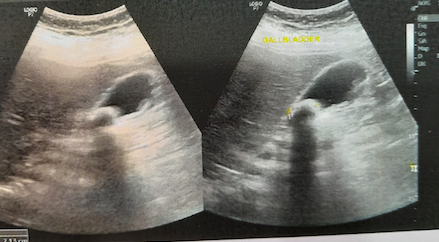[1]
Siegel RL, Miller KD, Jemal A. Cancer Statistics, 2017. CA: a cancer journal for clinicians. 2017 Jan:67(1):7-30. doi: 10.3322/caac.21387. Epub 2017 Jan 5
[PubMed PMID: 28055103]
[2]
Goetze TO. Gallbladder carcinoma: Prognostic factors and therapeutic options. World journal of gastroenterology. 2015 Nov 21:21(43):12211-7. doi: 10.3748/wjg.v21.i43.12211. Epub
[PubMed PMID: 26604631]
[3]
Benson AB, D'Angelica MI, Abrams T, Abbott DE, Ahmed A, Anaya DA, Anders R, Are C, Bachini M, Binder D, Borad M, Bowlus C, Brown D, Burgoyne A, Castellanos J, Chahal P, Cloyd J, Covey AM, Glazer ES, Hawkins WG, Iyer R, Jacob R, Jennings L, Kelley RK, Kim R, Levine M, Palta M, Park JO, Raman S, Reddy S, Ronnekleiv-Kelly S, Sahai V, Singh G, Stein S, Turk A, Vauthey JN, Venook AP, Yopp A, McMillian N, Schonfeld R, Hochstetler C. NCCN Guidelines® Insights: Biliary Tract Cancers, Version 2.2023. Journal of the National Comprehensive Cancer Network : JNCCN. 2023 Jul:21(7):694-704. doi: 10.6004/jnccn.2023.0035. Epub
[PubMed PMID: 37433432]
[4]
Roa I, Araya JC, Villaseca M, De Aretxabala X, Riedemann P, Endoh K, Roa J. Preneoplastic lesions and gallbladder cancer: an estimate of the period required for progression. Gastroenterology. 1996 Jul:111(1):232-6
[PubMed PMID: 8698204]
[5]
Alshahri TM, Abounozha S. Best evidence topic: Does the presence of a large gallstone carry a higher risk of gallbladder cancer? Annals of medicine and surgery (2012). 2021 Jan:61():93-96. doi: 10.1016/j.amsu.2020.12.023. Epub 2020 Dec 28
[PubMed PMID: 33425346]
[6]
Liu K, Katelaris P. Education and imaging. Gastrointestinal: Porcelain gallbladder. Journal of gastroenterology and hepatology. 2015 Apr:30(4):648. doi: 10.1111/jgh.12860. Epub
[PubMed PMID: 25776955]
[7]
Sarici IS, Duzgun O. Gallbladder polypoid lesions }15mm as indicators of T1b gallbladder cancer risk. Arab journal of gastroenterology : the official publication of the Pan-Arab Association of Gastroenterology. 2017 Sep:18(3):156-158. doi: 10.1016/j.ajg.2017.09.003. Epub 2017 Sep 27
[PubMed PMID: 28958638]
[8]
Wu T, Sun Z, Jiang Y, Yu J, Chang C, Dong X, Yan S. Strategy for discriminating cholesterol and premalignancy in polypoid lesions of the gallbladder: a single-centre, retrospective cohort study. ANZ journal of surgery. 2019 Apr:89(4):388-392. doi: 10.1111/ans.14961. Epub 2018 Nov 29
[PubMed PMID: 30497105]
Level 2 (mid-level) evidence
[9]
Akki AS, Zhang W, Tanaka KE, Chung SM, Liu Q, Panarelli NC. Systematic Selective Sampling of Cholecystectomy Specimens Is Adequate to Detect Incidental Gallbladder Adenocarcinoma. The American journal of surgical pathology. 2019 Dec:43(12):1668-1673. doi: 10.1097/PAS.0000000000001351. Epub
[PubMed PMID: 31464710]
Level 1 (high-level) evidence
[10]
Su J, Liang Y, He X. Global, regional, and national burden and trends analysis of gallbladder and biliary tract cancer from 1990 to 2019 and predictions to 2030: a systematic analysis for the Global Burden of Disease Study 2019. Frontiers in medicine. 2024:11():1384314. doi: 10.3389/fmed.2024.1384314. Epub 2024 Apr 4
[PubMed PMID: 38638933]
Level 1 (high-level) evidence
[11]
Sharma A, Sharma KL, Gupta A, Yadav A, Kumar A. Gallbladder cancer epidemiology, pathogenesis and molecular genetics: Recent update. World journal of gastroenterology. 2017 Jun 14:23(22):3978-3998. doi: 10.3748/wjg.v23.i22.3978. Epub
[PubMed PMID: 28652652]
[12]
Giraldo NA, Drill E, Satravada BA, Dika IE, Brannon AR, Dermawan J, Mohanty A, Ozcan K, Chakravarty D, Benayed R, Vakiani E, Abou-Alfa GK, Kundra R, Schultz N, Li BT, Berger MF, Harding JJ, Ladanyi M, O'Reilly EM, Jarnagin W, Vanderbilt C, Basturk O, Arcila ME. Comprehensive Molecular Characterization of Gallbladder Carcinoma and Potential Targets for Intervention. Clinical cancer research : an official journal of the American Association for Cancer Research. 2022 Dec 15:28(24):5359-5367. doi: 10.1158/1078-0432.CCR-22-1954. Epub
[PubMed PMID: 36228155]
[13]
Roa JC, Basturk O, Adsay V. Dysplasia and carcinoma of the gallbladder: pathological evaluation, sampling, differential diagnosis and clinical implications. Histopathology. 2021 Jul:79(1):2-19. doi: 10.1111/his.14360. Epub 2021 May 6
[PubMed PMID: 33629395]
[14]
Bosch DE, Yeh MM, Schmidt RA, Swanson PE, Truong CD. Gallbladder carcinoma and epithelial dysplasia: Appropriate sampling for histopathology. Annals of diagnostic pathology. 2018 Dec:37():7-11. doi: 10.1016/j.anndiagpath.2018.08.003. Epub 2018 Sep 5
[PubMed PMID: 30216818]
[15]
Prasad TL, Kumar A, Sikora SS, Saxena R, Kapoor VK. Mirizzi syndrome and gallbladder cancer. Journal of hepato-biliary-pancreatic surgery. 2006:13(4):323-6
[PubMed PMID: 16858544]
[16]
Furlan A, Ferris JV, Hosseinzadeh K, Borhani AA. Gallbladder carcinoma update: multimodality imaging evaluation, staging, and treatment options. AJR. American journal of roentgenology. 2008 Nov:191(5):1440-7. doi: 10.2214/AJR.07.3599. Epub
[PubMed PMID: 18941083]
[17]
Strom BL, Maislin G, West SL, Atkinson B, Herlyn M, Saul S, Rodriguez-Martinez HA, Rios-Dalenz J, Iliopoulos D, Soloway RD. Serum CEA and CA 19-9: potential future diagnostic or screening tests for gallbladder cancer? International journal of cancer. 1990 May 15:45(5):821-4
[PubMed PMID: 2335386]
[18]
Agarwal AK, Kalayarasan R, Javed A, Gupta N, Nag HH. The role of staging laparoscopy in primary gall bladder cancer--an analysis of 409 patients: a prospective study to evaluate the role of staging laparoscopy in the management of gallbladder cancer. Annals of surgery. 2013 Aug:258(2):318-23. doi: 10.1097/SLA.0b013e318271497e. Epub
[PubMed PMID: 23059504]
[19]
Butte JM, Gönen M, Allen PJ, D'Angelica MI, Kingham TP, Fong Y, Dematteo RP, Blumgart L, Jarnagin WR. The role of laparoscopic staging in patients with incidental gallbladder cancer. HPB : the official journal of the International Hepato Pancreato Biliary Association. 2011 Jul:13(7):463-72. doi: 10.1111/j.1477-2574.2011.00325.x. Epub 2011 Jun 7
[PubMed PMID: 21689230]
[20]
Fuks D, Regimbeau JM, Pessaux P, Bachellier P, Raventos A, Mantion G, Gigot JF, Chiche L, Pascal G, Azoulay D, Laurent A, Letoublon C, Boleslawski E, Rivoire M, Mabrut JY, Adham M, Le Treut YP, Delpero JR, Navarro F, Ayav A, Boudjema K, Nuzzo G, Scotte M, Farges O. Is port-site resection necessary in the surgical management of gallbladder cancer? Journal of visceral surgery. 2013 Sep:150(4):277-84. doi: 10.1016/j.jviscsurg.2013.03.006. Epub 2013 May 9
[PubMed PMID: 23665059]
[21]
Apisarnthanarax S, Barry A, Cao M, Czito B, DeMatteo R, Drinane M, Hallemeier CL, Koay EJ, Lasley F, Meyer J, Owen D, Pursley J, Schaub SK, Smith G, Venepalli NK, Zibari G, Cardenes H. External Beam Radiation Therapy for Primary Liver Cancers: An ASTRO Clinical Practice Guideline. Practical radiation oncology. 2022 Jan-Feb:12(1):28-51. doi: 10.1016/j.prro.2021.09.004. Epub 2021 Oct 21
[PubMed PMID: 34688956]
Level 1 (high-level) evidence
[22]
Ben-Josef E, Guthrie KA, El-Khoueiry AB, Corless CL, Zalupski MM, Lowy AM, Thomas CR Jr, Alberts SR, Dawson LA, Micetich KC, Thomas MB, Siegel AB, Blanke CD. SWOG S0809: A Phase II Intergroup Trial of Adjuvant Capecitabine and Gemcitabine Followed by Radiotherapy and Concurrent Capecitabine in Extrahepatic Cholangiocarcinoma and Gallbladder Carcinoma. Journal of clinical oncology : official journal of the American Society of Clinical Oncology. 2015 Aug 20:33(24):2617-22. doi: 10.1200/JCO.2014.60.2219. Epub 2015 May 11
[PubMed PMID: 25964250]
[23]
Ilyas SI, Khan SA, Hallemeier CL, Kelley RK, Gores GJ. Cholangiocarcinoma - evolving concepts and therapeutic strategies. Nature reviews. Clinical oncology. 2018 Feb:15(2):95-111. doi: 10.1038/nrclinonc.2017.157. Epub 2017 Oct 10
[PubMed PMID: 28994423]
[24]
Primrose JN, Fox RP, Palmer DH, Malik HZ, Prasad R, Mirza D, Anthony A, Corrie P, Falk S, Finch-Jones M, Wasan H, Ross P, Wall L, Wadsley J, Evans JTR, Stocken D, Praseedom R, Ma YT, Davidson B, Neoptolemos JP, Iveson T, Raftery J, Zhu S, Cunningham D, Garden OJ, Stubbs C, Valle JW, Bridgewater J, BILCAP study group. Capecitabine compared with observation in resected biliary tract cancer (BILCAP): a randomised, controlled, multicentre, phase 3 study. The Lancet. Oncology. 2019 May:20(5):663-673. doi: 10.1016/S1470-2045(18)30915-X. Epub 2019 Mar 25
[PubMed PMID: 30922733]
Level 1 (high-level) evidence
[25]
Rizzo A, Brandi G. BILCAP trial and adjuvant capecitabine in resectable biliary tract cancer: reflections on a standard of care. Expert review of gastroenterology & hepatology. 2021 May:15(5):483-485. doi: 10.1080/17474124.2021.1864325. Epub 2020 Dec 18
[PubMed PMID: 33307876]
[26]
Lamarca A, Edeline J, McNamara MG, Hubner RA, Nagino M, Bridgewater J, Primrose J, Valle JW. Current standards and future perspectives in adjuvant treatment for biliary tract cancers. Cancer treatment reviews. 2020 Mar:84():101936. doi: 10.1016/j.ctrv.2019.101936. Epub 2019 Dec 4
[PubMed PMID: 31986437]
Level 3 (low-level) evidence
[27]
Rizzo A, Brandi G. Neoadjuvant therapy for cholangiocarcinoma: A comprehensive literature review. Cancer treatment and research communications. 2021:27():100354. doi: 10.1016/j.ctarc.2021.100354. Epub 2021 Mar 16
[PubMed PMID: 33756174]
[28]
Ebia MI, Sankar K, Osipov A, Hendifar AE, Gong J. TOPAZ-1: a new standard of care for advanced biliary tract cancers? Immunotherapy. 2023 May:15(7):473-476. doi: 10.2217/imt-2022-0269. Epub 2023 Mar 23
[PubMed PMID: 36950948]
[29]
Almhanna K. Immune checkpoint inhibitors in combination with chemotherapy for patients with biliary tract cancer: what did we learn from TOPAZ-1 and KEYNOTE-966. Translational cancer research. 2024 Jan 31:13(1):22-24. doi: 10.21037/tcr-23-1763. Epub 2024 Jan 17
[PubMed PMID: 38410206]
[30]
Kelley RK, Bridgewater J, Gores GJ, Zhu AX. Systemic therapies for intrahepatic cholangiocarcinoma. Journal of hepatology. 2020 Feb:72(2):353-363. doi: 10.1016/j.jhep.2019.10.009. Epub
[PubMed PMID: 31954497]




